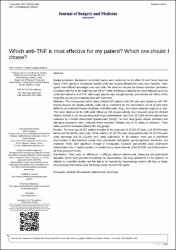| dc.contributor.author | Pamukcu, Melih | |
| dc.contributor.author | Aydoğan Baykara, Rabia | |
| dc.date.accessioned | 2022-04-22T08:43:54Z | |
| dc.date.available | 2022-04-22T08:43:54Z | |
| dc.date.issued | 2021 | en_US |
| dc.identifier.citation | Pamukcu, M., & Baykara, R. A. (2021). Which anti-TNF is most effective for my patient? Which one should I choose?. Journal of Surgery and Medicine, 5(9), 941-945. | en_US |
| dc.identifier.uri | https://doi.org/10.28982/josam.984025 | |
| dc.identifier.uri | http://jsurgmed.com/en/pub/issue/64812/984025 | |
| dc.identifier.uri | https://hdl.handle.net/20.500.12899/1027 | |
| dc.description.abstract | Background/Aim: Multicenter controlled studies were conducted on the effect of anti-Tumor Necrosis
Factor (TNF) agents in rheumatoid arthritis (RA) and varying effectiveness rates were reported. These
agents have different advantages over each other. We aimed to compare the disease activation parameters
in patients with RA at the beginning and the 52nd week of therapy in patients who were followed up in our
center and started on anti-TNF (etanercept, adalimumab, and golimumab), and examine the effects of the
drugs that are used by comparing them with each other.
Methods: This retrospective cohort study included 187 patients with RA who were started on anti-TNF
therapy because the disease activity could not be controlled by the concomitant use of at least three
different conventional Disease-Modifying Anti-Rheumatic drugs, and whose adequate response to antiTNF were observed at the 12th-week follow-up. RA disease activity was measured using the 28-joint
Disease Activity Score incorporating erythrocyte sedimentation rate (DAS-28 ESR) and the patients were
evaluated by a Health Assessment Questionnaire (HAQ). For each drug group, disease activation and
laboratory parameters were compared before treatment initiation and at 52 weeks of treatment. These
values were then compared between the drug groups.
Results: The mean age of 187 patients included in the study was 52.70 (10.17) years, 119 (63.6%) were
female and 68 (36.4%) were male. Of the patients, 63 (33.7%) were using adalimumab, 62 (33.2%) were
using etanercept and 62 (33.2%) were using golimumab. In all patients, there was a significant
improvement in all parameters except mean corpuscular hemoglobin, gamma-glutamyl transferase, and
creatinine. There were significant changes in hemoglobin, leukocyte and platelet count, erythrocyte
sedimentation rate, C reactive protein, neutrophil count, serum albumin, DAS-28 ESR, and HAQ levels in
all three groups (P<0.05).
Conclusion: There were no differences in efficacy between adalimumab, etanercept and golimumab
therapies, which were planned considering the comorbidities and drug preferences of the patients. In
addition to controlled studies, real-life data to be reported by rheumatology centers will help us obtain
more accurate information about the therapy results of anti-TNF agents. | en_US |
| dc.language.iso | en | en_US |
| dc.rights | info:eu-repo/semantics/openAccess | en_US |
| dc.subject | Arthritis | en_US |
| dc.subject | Rheumatoid | en_US |
| dc.subject | Adalimumab | en_US |
| dc.subject | Etanercept | en_US |
| dc.title | Which anti-TNF is most effective for my patient? Which one should I choose? | en_US |
| dc.type | Article | en_US |
| dc.department | MTÖ Üniversitesi, Tıp Fakültesi, Dahili Tıp Bilimleri Bölümü | en_US |
| dc.institutionauthor | Aydoğan Baykara, Rabia | |
| dc.identifier.doi | 10.28982/josam.984025 | |
| dc.identifier.volume | 5 | en_US |
| dc.identifier.issue | 9 | en_US |
| dc.identifier.startpage | 941 | en_US |
| dc.identifier.endpage | 945 | en_US |
| dc.relation.publicationcategory | Makale - Uluslararası Hakemli Dergi - Kurum Öğretim Elemanı | en_US |


















